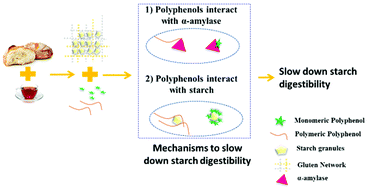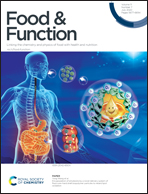Tea polyphenols as a strategy to control starch digestion in bread: the effects of polyphenol type and gluten†
Abstract
The inhibitory effect of tea polyphenols on starch digestibility can contribute to the control of the glycaemic index of starchy food. In this study, wheat bread and gluten-free bread were co-digested in vitro with different amounts of tea polyphenols. The kinetics of starch digestion and polyphenol bio-accessibility during in vitro digestion were monitored. The results showed that co-digestion of bread with tea polyphenols dose-dependently slowed the starch digestion kinetics and this effect is influenced by the types of polyphenols and the presence of gluten. The presence of gluten lowered the inhibitory efficacy of tannins on starch digestibility to 7.4% and 47.5% when 25 mg of tannins were co-digested with wheat bread and gluten-free bread, respectively. In contrast, the presence of gluten had little impact on the inhibitory efficacy of monomeric polyphenols. This study shows that the release of tea polyphenols in the digestive environment is a promising strategy for controlling the glycaemic index of starchy food and that monomeric and polymeric tea polyphenols differently affect starch digestion according to the presence of gluten.

- This article is part of the themed collections: Food & Function Recent HOT articles, International Conference on Polyphenols and Health (ICPH2019) collection and Food & Function Recent Open Access Articles


 Please wait while we load your content...
Please wait while we load your content...